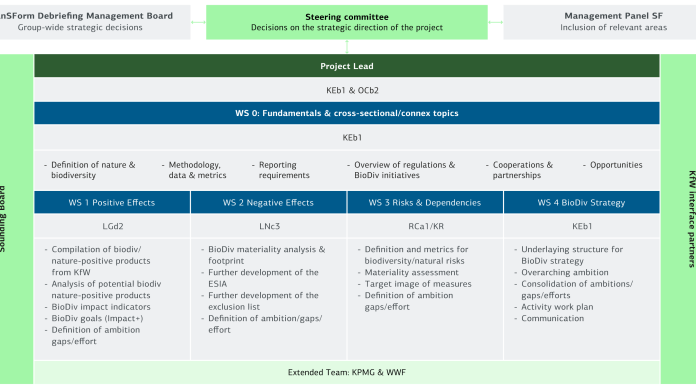Alongside the climate crisis, the biodiversity crisis is the greatest challenge of our time. According to a report on the state of nature in Europe, 81% of protected habitats in the EU are in poor condition. Our survival and the global economy depend on nature. This makes it essential for all stakeholders in society, including governments and businesses, to protect not only the climate, but also biodiversity and nature in equal measure. In 2023, KfW paved the way for the development of a biodiversity strategy with its Group-wide biodiversity roadmap.
Our economy relies on the ecosystem-based output provided by the living and non-living elements in nature: they are what give us the natural resources needed to produce food, medicines, building materials and more – and it does so without sending us a bill. This underlines the importance and value of biodiversity. Their loss and the collapse of the associated ecosystems is the third largest long-term (ten-year) risk, according to the World Economic Forum’s Global Risk Report 2024.
Moreover, a study by the European Central Bank shows that around 70 per cent of companies in Europe are heavily dependent on at least one ecosystem output. Our economy depends on nature and biodiversity. As a financial institution, KfW Group is likewise affected by the risks associated with the loss of biodiversity. A biodiversity strategy can help KfW to prepare for the identification and management of these risks. In addition, this strategy should increase resilience to the risks, amplify the positive effects and reduce the negative impacts on biodiversity. As a global development and promotional bank, we can have an influence and set a positive example.

In the first phase of the roadmap, a cross-departmental team was formed. In the current 2nd phase for the groundwork, five workstreams have been set up to pave the way for the biodiversity strategy:
Workstream 0 dealt with intersectional topics such as regulatory issues, strategic partnerships and opportunities. Workstreams 1 to 3 dealt with the positive impacts, negative impacts and risks and dependencies associated with biodiversity. The fourth workstream is all about devising a future strategy. Various colleagues from KfW Group were involved in this project phase - from IPEX, DEG, Capital, KfW Development Bank, Germany, Financial Markets, Risk Controlling, Credit Risk Management, Group Development and Strategy.
The multidisciplinary approach applied in the roadmap characterises our strategy. Other banks apply strategies that are limited to the risks alone. By contrast, we aim to pay particular attention to opportunities. We need to contribute to better biodiversity management and identify business opportunities in this context.
KPMG and WWF are supporting us in tackling this complex biodiversity issue in the groundwork phase. We are also in contact with institutions and organizations that give us feedback and the impetus to ensure the roadmap takes all the important elements into account.
With the roadmap, we are indicating what needs to be done to develop a Group-wide biodiversity strategy:

The development of the strategy is the goal of the roadmap. The strategy will be created in the next phase, which begins in 2025. Once the strategy has been developed, a governance structure will be needed to implement it. At this stage, it is still too early to say who exactly will be involved. However, it will be a strategy for the entire banking group and it is therefore expected that several specialist and business divisions will play a role, depending on their tasks.
In order to have a solid BioDiv strategy, we will define goals that each have different KPIs. Once we have defined these, we need to develop a monitoring system to ensure that the milestones are achieved. All of this will be clarified in the strategy that will be developed in the next phase of the roadmap.
Share page
To share the content of this page with your network, click on one of the icons below.
Note on data protection: When you share content, your personal data is transferred to the selected network.
Data protection
Alternatively, you can also copy the short link: https://www.kfw.de/s/ennB1aCq
Copy link Link copied